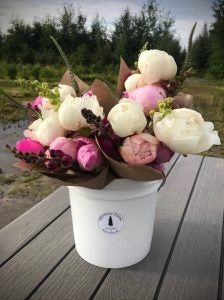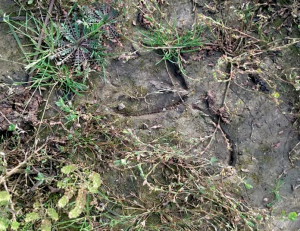Every time I travel, I always try to submerse myself in local agriculture. On a recent trip to Alaska, a small, local peony and flower farm called Slimtree Farm did not disappoint.
Ronda and Brian Schlumbohm have 40 acres in North Pole, Alaska, where they grow flowers on about 3 acres and sell direct to local businesses, special events, and through a CSA. With 27 peony varieties and about 3,000 plants, the farm sells approximately 5,000 organically grown peonies in the community where they’ve been farming since 2014.

Flower farming in Alaska is on the rise, partly due to the fact that while other parts of the world are productive for flowers for most of the year, Alaska’s colder climate provides them in the midst of summer where countries like New Zealand, Australia, Israel, and the Netherlands might not be as productive. Alaskan flowers grow in the spring and are harvested in July.
As a second-grade teacher, Ronda is passionate about both flowers and education, so the farm gives her a great secondary career during summer break. The knowledgeable couple are self taught — they spend a lot of time reading books and taking online flower classes. They were originally inspired to start the farm after watching gardening films on Amazon Prime, while reading “Peonies” by plant breeder Allan Rogers and books by Erin Benzakein, owner of “Floret” farm.

The couple got 300 plants growing in their first year of business, which was their 25th wedding anniversary! Peonies typically take three years to produce their first flowers, so it’s been a slow and steady work in progress. The farm prides themselves on organic farming practices, where they work with nature and create diversification to improve pollinator habitat, help bees, and get creative with bouquet fillers. A couple examples? The couple has wild raspberries, Tamarack trees, and other natural forage greens that look beautiful in their arrangements.

Fortunately they don’t have a lot of issues with pests, but they do work with natural insect predators and have worked with University of Alaska-Fairbanks on research. Insect pressure does play a small role, but the farm is smaller scale so they don’t really need to use pesticides. The flowers were harvested, and now the plants will be cut down and the grass and weeds will be cleared to prep for winter.
One of the the coolest things I saw on the farm related to nature: moose tracks!

When the couple were first getting the farm ready, they had to purchase soil to create mounds for the plants. They also use weed barrier, drip tape irrigation, and get Alaskan bonemeal fertilizer from Anchorage, where farmers get together to split the cost of getting it up to them in the Fairbanks area.
When asked why they decided to start a flower farm, Rhonda explained how she’s always loved growing things. They also really love flowers because they brighten people’s days. They’ve cheered people up during COVID-19, sending flowers to the seniors center and to families who are going through a tough time.
“I’m lucky that I do things I love,” she says for her love of teaching and flowers.
When it comes to the future of their farm, they see “2 acres as a gateway drug!” Brian says, jokingly. Yes, they have plans for expansion, to possibly do weddings, Christmas trees, and other special events.
Many people dream of starting a small farm of their own someday. With the right drive, goals, desire for knowledge, and ambition, anything is possible when it comes to making a hobby farm dream come true.
Michelle Miller, the Farm Babe, is an Iowa-based farmer, public speaker, and writer, who lives and works with her boyfriend on their farm, which consists of row crops, beef cattle, and sheep. She believes education is key in bridging the gap between farmers and consumers.



